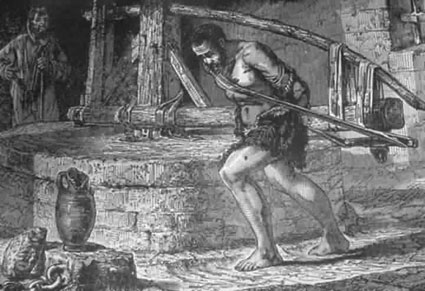50 Failed Predictions? – #6
26. Christ returned in A.D. 70 (?), but according to preterists the literal cloud was missing (see Acts 1: 9; Matt. 24: 30; Rev. 1: 7).
The “Bible matrix” pattern always begins with a Word from God’s glory cloud on the Lord’s Day (Sabbath), the accepted Mediator received into this single-cloud “Tabernacle” (Firstfruits) and ends with multiple clouds, a corporate Mediator (the body). The Feast of Tabernacles (“succoth”) is literally the Feast of Clouds. This was fulfilled in AD70. Christ ascended to prepare the place, and the firstfruits church was received into it at the destruction of the Temple.
See also Not Just Any Old Cloud.
27. Israel never repented in A.D. 70 (Acts 3:19-21).
Paul wrote, “They are not all Israel which are of Israel.” The Word of God is always a sword that divides in two. That is the sword that Jesus brought. Many Jews converted, but many hardened their hearts. Many converts died to fulfill the first goat, many more hard-hearted hardliners died to fulfill the second. After the end of the Temple, over the next two centuries, many Jews converted to Christianity. The will of God concerning Judaism, and His wisdom throughout this “harvest”, had been made plain to all.
28. Christ said the nation won’t see Him until they repent. Matt. 23: 39. According to preterists “every eye saw Him” in A.D. 70.
The context of this verse is undeniably first century—unless of course we resort to some wild “postponement” theory that divorces these predictions from the historical destruction of Jerusalem.
Jesus’ mention of eyes is the product of the literary structure:
- Eyes at the centre of the chiasm refer to the “seven eyes” of the Law. Christ died under the Law, but He was filled with the Law. He became the Lamb with seven eyes—and seven horns to gore the Law’s offenders with! The seven Lampstand eyes are opened as seven seals (Pentecost) which in turn blow seven Trumpets, which result in seven bowls of wrath (Atonement).
- When they appear at the end of the structure (Tabernacles) it is the eyes of God inside a Man. (For more on this, see Eye Spy – 1.)
The idea is that Adam is given two eyes to judge with—two witnesses. If he judges rightly between good and evil in the light of God’s Law (which he heard with two ears), he becomes a “Solomon” at the end of the process. His judgment is the Law incarnate. He is given (symbolically) seven eyes. If, however, he fails to judge with his two eyes, at the end of the process, the Lord visits the Garden and Adam is judged under God’s seven eyes. And Adam, like Isaac, Eli, Samson, etc., loses his two eyes. The process starts again with a fresh Word from God. What’s interesting is that after Isaac’s lack of judgment concerning the blessing, his judgment later returns concerning a bride for Jacob. He follows the example of Abraham and sends to Laban. The literary structure puts his “coming to” at the centre. His spiritual eyes had been reopened. I bet judges does the same with Samson also.
So, to get back to the question, “every eye” is a sudden return to sound judgment. The faithful martyrs literally did see Christ. They did “see him face to face” as did Jacob and Job, both of whom wrestled with God and prevailed. The Judaisers would realise God was actually against them. They would lose their eyes—and their sons—like Zedekiah. This last step often concerns Sabbath-wisdom and Covenant succession. The Jews who mourned the death of the Son repented. Those who wouldn’t mourn (ie. “I sit a queen and am no widow” Herodian worship) did not repent.
29. The land was smitten with the curse. According to preterists, John the Baptist failed. See Mal. 4: 5-6.
The gospel is a “liberating curse.” It kills the “Canaanites” and frees the faithful “Rahabs.”
Revelation describes the gospel as four horsemen. Word-Division-Fullness/Starvation-Judgment. It was a winnowing process. The Old Covenant “bread” became expensive, but the New Covenant oil and wine were not harmed. The book of Ruth follows the same pattern. Bethlehem (“house of bread”) begins in famine, the old generation is killed off by God “in the fields of Moab” [as spiritual harlotry], but the Lord builds a new body out of Jew and Gentile, and Bethlehem is again a house of bread. Herod was eaten alive by maggots and his big white house of bread Temple was eaten alive by Romans who tore up the masonry looking for gold. Maggots, and I guess Romans, only eat death. They cleaned the open wound wrought by the gospel sword while the chaste virgin bride feasted with the Bridegroom in heaven. Two goats, two parties. One on the mountain/Altar of God and one on the Altar of the Abyss. [1]
See Totus Christus for more on this theme: the “liberating curse”, especially the notes on Zechariah 5.
30. The living saints weren’t rewarded in A.D. 70. Matt. 16: 27-28. (According, they had to wait until death!).
The context of this passage is first century martyrdom. Those who were rewarded were actually dead by that time. This ties in with Hebrew’s exhortation to boldly draw near. See The Context of Drawing Near.
“But if anyone draws back, my soul has no pleasure in him.” Hebrews 10:38
50FPDZ


























